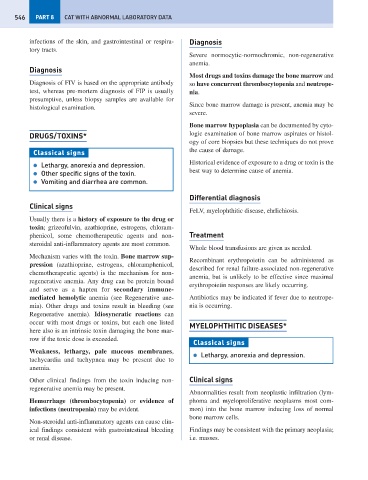Page 554 - Problem-Based Feline Medicine
P. 554
546 PART 8 CAT WITH ABNORMAL LABORATORY DATA
infections of the skin, and gastrointestinal or respira- Diagnosis
tory tracts.
Severe normocytic-normochromic, non-regenerative
anemia.
Diagnosis
Most drugs and toxins damage the bone marrow and
Diagnosis of FIV is based on the appropriate antibody so have concurrent thrombocytopenia and neutrope-
test, whereas pre-mortem diagnosis of FIP is usually nia.
presumptive, unless biopsy samples are available for
Since bone marrow damage is present, anemia may be
histological examination.
severe.
Bone marrow hypoplasia can be documented by cyto-
DRUGS/TOXINS* logic examination of bone marrow aspirates or histol-
ogy of core biopsies but these techniques do not prove
the cause of damage.
Classical signs
Historical evidence of exposure to a drug or toxin is the
● Lethargy, anorexia and depression.
best way to determine cause of anemia.
● Other specific signs of the toxin.
● Vomiting and diarrhea are common.
Differential diagnosis
Clinical signs
FeLV, myelophthitic disease, ehrlichiosis.
Usually there is a history of exposure to the drug or
toxin; grizeofulvin, azathioprine, estrogens, chloram-
phenicol, some chemotherapeutic agents and non- Treatment
steroidal anti-inflammatory agents are most common.
Whole blood transfusions are given as needed.
Mechanism varies with the toxin. Bone marrow sup-
Recombinant erythropoietin can be administered as
pression (azathioprine, estrogens, chloramphenicol,
described for renal failure-associated non-regenerative
chemotherapeutic agents) is the mechanism for non-
anemia, but is unlikely to be effective since maximal
regenerative anemia. Any drug can be protein bound
erythropoietin responses are likely occurring.
and serve as a hapten for secondary immune-
mediated hemolytic anemia (see Regenerative ane- Antibiotics may be indicated if fever due to neutrope-
mia). Other drugs and toxins result in bleeding (see nia is occurring.
Regenerative anemia). Idiosyncratic reactions can
occur with most drugs or toxins, but each one listed
MYELOPHTHITIC DISEASES*
here also is an intrinsic toxin damaging the bone mar-
row if the toxic dose is exceeded.
Classical signs
Weakness, lethargy, pale mucous membranes,
● Lethargy, anorexia and depression.
tachycardia and tachypnea may be present due to
anemia.
Other clinical findings from the toxin inducing non- Clinical signs
regenerative anemia may be present.
Abnormalities result from neoplastic infiltration (lym-
Hemorrhage (thrombocytopenia) or evidence of phoma and myeloproliferative neoplasms most com-
infections (neutropenia) may be evident. mon) into the bone marrow inducing loss of normal
bone marrow cells.
Non-steroidal anti-inflammatory agents can cause clin-
ical findings consistent with gastrointestinal bleeding Findings may be consistent with the primary neoplasia;
or renal disease. i.e. masses.

